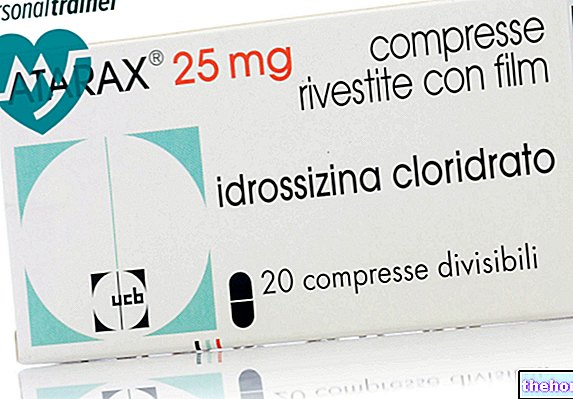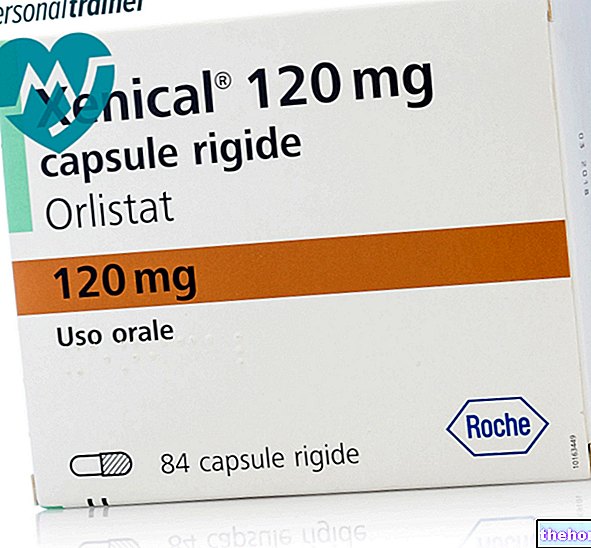Active ingredients: Progesterone
Prometrium 100 mg soft capsules for oral and vaginal use
Prometrium 200 mg soft capsules for oral and vaginal use
Why is Prometrium used? What is it for?
Prometrium belongs to the pharmaceutical category of sex hormones and regulators of the genital system (progestins).
Oral use
Prometrium is used for disorders due to insufficient production of the hormone progesterone (progestin insufficiency), in particular in the case of:
- symptoms that precede menstruation (PMS),
- alterations of the cycle,
- breast lumps (benign mastopathies),
- menstrual irregularities in the period preceding the definitive cessation of the menstrual cycle (premenopause),
- menopausal hormone replacement therapy (in combination with estrogen hormone therapy).
Vaginal use (represents an "alternative to" oral use)
Prometrium is used as:
- progestogen hormone supplement in the last phase of the menstrual cycle, after ovulation (luteal phase) during spontaneous or induced cycles, in case of lower than normal reproductive capacity (hypofertility) or insufficient response of the ovaries to normal stimulation (insufficiency primary or secondary ovarian).
- in case of threat of abortion or in the prevention of repeated abortions due to ascertained insufficient production of progesterone by the ovary in the last phase of the menstrual cycle (luteal insufficiency), up to the 12th week of absence of menstruation (amenorrhea).
Contraindications When Prometrium should not be used
Do not take Prometrium
- if you are allergic to progesterone, chemically closely related substances or any of the other ingredients of this medicine
- if you suffer from severe impairment of liver function (severe liver failure);
- if you have vaginal bleeding of an unknown nature;
- in case of internal or incomplete abortion;
- if you have or have suffered in the past from blockage of blood vessels caused by blood clots (thromboembolism);
- if you have or suspect that you have cancer of the breast (breast cancer) or cancer of the genital system;
- if you suffer from inflammation of the superficial veins associated with the formation of blood clots (thrombophlebitis);
- if you have suffered a rupture of a blood vessel in the area of the brain (brain haemorrhage).
Precautions for use What you need to know before taking Prometrium
Talk to your doctor or pharmacist before taking this medicine.
The treatment, at the recommended doses for use, is not a contraceptive (it does not prevent a possible pregnancy).
Before starting treatment, you should undergo a thorough general and gynecological examination (pelvic and breast examination), including a Pap test.
As progesterone can cause some fluid accumulation (retention), your doctor will need to monitor you closely if you have any of the following conditions as they may be affected by this factor:
- neurological condition characterized by overactivity of certain nerve cells leading to unconsciousness and seizures (epilepsy),
- headache usually on one side only (migraine),
- inflammatory disease characterized by a usually reversible narrowing of the lower airways (asthma),
- inability of the heart to pump an "adequate amount of blood (heart failure),
- reduced kidney function (kidney failure).
Talk to your doctor especially if:
- you have vaginal bleeding, because in cases of bleeding from the uterus outside the menstrual periods (metrorrhagia) of an unknown nature, your doctor will identify the causes before treatment;
- have a history of depression; in this case your doctor will have to carefully monitor your condition during treatment;
- suffer from diabetes, as progestogens can cause or aggravate fluid retention and reduce glucose tolerance;
- symptoms of partial or total loss of vision or double vision appear during treatment;
- must perform an examination of some tissue taken by biopsy (histological examination); your doctor needs to know that you are taking Prometrium.
If you are premenopausal, be aware that progestin treatment can mask the onset of menopause.
Following treatment with progesterone, alterations in the tests on glandular systems or in liver function may occur.
Stop treatment at the first symptoms of a disorder caused by the formation of blood clots (thrombi) in the peripheral, brain or lung vessels.
Your doctor will prescribe Prometrium only in case of insufficient progesterone production by the ovary in the last phase of the menstrual cycle (luteal insufficiency), as this medicine is not a treatment for spontaneous abortion. The only effect of the administration of progesterone in case of spontaneous abortions, generally due to genetic complications or infectious diseases and mechanical disorders, would in fact be to delay the evacuation of a lifeless oocyte or the termination of a pregnancy that will not be able to in any case be completed.
Limited to the use of Prometrium in menopausal disorders in association with hormone replacement therapy (HRT), please consider the following
Before starting or resuming HRT, your doctor will ask you about your personal and family medical history (medical history) and will undergo a thorough general and gynecological examination (including pelvic and breast examination). on the basis of the medical history, contraindications and warnings for use.
During your HRT treatment you will need to undergo periodic medical check-ups the nature and frequency of which will be adapted to your individual needs in order to accurately assess the risks and benefits in relation to continuing therapy. You will need to undergo clinical investigations, including mammography, in accordance with the follow-up programs currently in use and should notify your doctor of any changes.
If you are in the menopause, HRT increases the likelihood of being diagnosed with breast cancer from mild to moderate. This may be due to either an early diagnosis, a real effect of HRT, or a combination of both.
The likelihood of breast cancer being diagnosed increases with duration of treatment and appears to return to baseline five years after stopping HRT. Breast cancer diagnosed in patients using or having recently used HRT would appear to be less invasive in nature than that found in untreated women.
In women between the ages of fifty and seventy who are not using HRT, about 45 in every 1000 people are diagnosed with breast cancer, with an increase related to age. It has been estimated that in women who use HRT for at least five years, the number of additional cases of breast cancer diagnosed will be between 2 and 12 in 1000, this in relation to the age at which patients start treatment and how long it lasts.
Your doctor will discuss with you the increased likelihood of being diagnosed with breast cancer in long-term therapy, weighing it against the benefits of HRT.
You will be closely monitored if you have a family history of cancer or if you have or have suffered from:
- a blockage of recurrent biliary excretion (cholestasis) or persistent itching during pregnancy;
- changes in liver function;
- kidney or heart failure;
- breast lumps or diffuse lumps in both breasts (fibrocystic mastopathy);
- epilepsy;
- asthma;
- an ear disease that occurs with decreased hearing (otosponginosis);
- diabetes mellitus;
- an autoimmune disease affecting the central nervous system (multiple sclerosis);
- a disease of the immune system (systemic lupus erythematosus).
Interactions Which drugs or foods may change the effect of Prometrium
Tell your doctor or pharmacist if you are taking, have recently taken or might take any other medicines.
Progesterone can affect the effects of a substance shown to correct hormonal imbalances (bromocriptine).
Warnings It is important to know that:
Pregnancy and breastfeeding
If you are pregnant or breast-feeding, think you may be pregnant or are planning to have a baby, ask your doctor or pharmacist for advice before taking this medicine.
You can only use Prometrium during the 1st trimester of pregnancy and only vaginally. Prometrium is not a treatment for the induction of premature labor.
If you take micronized progesterone during the second and third trimester of pregnancy you may experience a yellowish discoloration of the skin, whites of the eyes and mucous membranes caused by blockage of biliary excretion (cholestatic jaundice) or liver cell disease.
Driving and using machines
Use caution when driving and using machines as this medicine can cause drowsiness and dizziness.
Dosage and method of use How to use Prometrium: Dosage
Always take this medicine exactly as your doctor or pharmacist has told you.
If in doubt, consult your doctor or pharmacist. The recommended doses must be absolutely respected.
The dose should not exceed 200 mg for each administration, regardless of the indication and route of administration (oral or vaginal).
Oral use
On average, for an insufficient production of the hormone progesterone (progestin insufficiency), the daily dose is 200-300 mg of progesterone.
It is recommended to take the medicine between meals
In case of insufficient production of progesterone by the ovary in the last phase of the menstrual cycle (luteal insufficiency), in particular in the premenstrual syndrome, diffuse nodularity of the breasts (benign mastopathies), cycle alterations, premenopause, the daily dose is 200-300 mg of progesterone, for a therapeutic cycle of 10 days, usually from the 17th to the 26th day of the cycle.
In postmenopausal hormone replacement therapy (HRT), estrogen monotherapy is not recommended due to the risk of thickening of the lining of the uterus (endometrial hyperplasia). Progesterone should be given at a dose of 200 mg per day for 12-14 days per month, or during the last two weeks of each therapeutic cycle.
HRT should be discontinued for about a week during which vaginal bleeding may occur.
For these indications, in the case of liver disease (liver disease) and side effects due to progesterone (drowsiness after oral administration), vaginal use should be used as an alternative to oral use with the same doses.
Vaginal use
Insert each capsule deeply into the vagina.
As a supplement in the last phase of the menstrual cycle, post-ovulatory (luteal phase) during spontaneous or induced cycles, in case of reduced reproductive capacity or primary or secondary sterility, particularly in case of ovulation alteration, the recommended daily dose is 200-300 mg per day, starting on the 17th day of the cycle for 10 consecutive days. The treatment should be repeated, as soon as possible, in the case of absence of menstruation (amenorrhea) and confirmed pregnancy.
In case of a threat of miscarriage or prevention of repeated miscarriages due to insufficient progesterone production in the luteal phase, the recommended daily dose is 200-400 mg per day.
Overdose What to do if you have taken too much Prometrium
If you take more Prometrium than you should
If you accidentally swallow / take too much Prometrium, notify your doctor immediately or go to the nearest hospital.
If you forget to take Prometrium
Do not take a double dose to make up for a forgotten previous dose.
If you have any further questions on the use of this medicine, ask your doctor or pharmacist.
Side Effects What are the side effects of Prometrium
Like all medicines, this medicine can cause side effects, although not everybody gets them.
Occasionally, there may be:
- sleepiness and dizziness for up to three hours after oral administration of Prometrium. In this case the dose should be reduced or readjusted (for example: 1 capsule of 200 mg or 2 capsules of 100 mg at bedtime, for 12-14 days each cycle). Vaginal administration may also be employed.
The following effects have also been reported:
- shortening of the menstrual cycle or bleeding from the uterus outside the menstrual periods (metrorrhagia). In these cases it is advisable to postpone the treatment for a few days (for example, start treatment on the 19th day of the cycle instead of the 17th day).
The following undesirable effects have been reported following administration of progestogens in general:
- intermenstrual bleeding,
- changes in menstrual flow,
- absence of menstruation (amenorrhea),
- alteration of the cervical mucus,
- breast pain (mastodynia),
- change in body weight (increase or decrease),
- yellowish discoloration of the skin, whites of the eyes and mucous membranes caused by blockage of biliary excretion (cholestatic jaundice),
- severe allergic reaction (anaphylaxis or anaphylactoid-type reactions),
- skin reactions (skin rash with or without itching), yellow-brown spots on the face during pregnancy (chloasma),
- fever
- insomnia
- nervousness
- depression
- headache (headache).
Compliance with the instructions contained in the package leaflet reduces the risk of undesirable effects.
Reporting of side effects
If you get any side effects, talk to your doctor or pharmacist. This includes any possible side effects not listed in this leaflet. You can also report side effects directly via the national reporting system at https://www.aifa.gov.it/content/segnalazioni-reazioni-avverse. By reporting side effects you can help provide more information on safety. of this medicine.
Expiry and Retention
Keep this medicine out of the sight and reach of children.
There are no special storage instructions.
Do not use this medicine after the expiry date which is stated on the package after "Expires on". The expiry date refers to the last day of that month. The expiry date refers to the product in intact packaging, correctly stored.
Do not throw any medicines via wastewater or household waste. Ask your pharmacist how to throw away medicines you no longer use. This will help protect the environment.
What Prometrium contains
100 mg soft capsule:
- The active ingredient is micronized progesterone. Each capsule contains 100 mg of micronized progesterone.
- The other ingredients are: sunflower oil, soy lecithin.
- The components of the capsule are: gelatin, glycerol, titanium dioxide.
Soft capsule of 200 mg:
- The active ingredient is micronized progesterone. Each capsule contains 200 mg micronized progesterone.
- The other ingredients are: sunflower oil, soy lecithin.
- The components of the capsule are: gelatin, glycerol, titanium dioxide.
Description of Prometrium's appearance and content
Soft capsules for oral or vaginal use.
Prometrium 100 mg: box of 30 capsules.
Prometrium 200 mg: box of 15 or 30 capsules
Source Package Leaflet: AIFA (Italian Medicines Agency). Content published in January 2016. The information present may not be up-to-date.
To have access to the most up-to-date version, it is advisable to access the AIFA (Italian Medicines Agency) website. Disclaimer and useful information.
01.0 NAME OF THE MEDICINAL PRODUCT
PROMETRIUM SOFT CAPSULES FOR ORAL AND VAGINAL USE
02.0 QUALITATIVE AND QUANTITATIVE COMPOSITION
Each 100 mg soft capsule contains:
Active principle: micronized progesterone 100 mg.
Each 200 mg soft capsule contains:
Active principle: micronized progesterone 200 mg.
For excipients see p. 6.1.
03.0 PHARMACEUTICAL FORM
Soft capsules for oral and vaginal use.
04.0 CLINICAL INFORMATION
04.1 Therapeutic indications
Oral use:
Disorders due to progestogen insufficiency, in particular:
-premenstrual syndrome,
- alterations of the cycle,
benign mastopathy
-premenopause
-menopausal hormone replacement therapy (as progestogen therapy to be combined with estrogen replacement therapy).
Vaginal use (represents an "alternative to" oral use):
- progestin supplement in the phase luteinica during spontaneous or induced cycles, in case of primary or secondary hypofertility or ovarian failure.
- in the event of a threat of abortion or in the prevention of repeated abortions due to ascertained insufficiency luteinica, up to the 12th week of amenorrhea.
04.2 Posology and method of administration
The recommended posologies must be absolutely respected.
The dose should not exceed 200 mg for each administration, regardless of the indication and route of administration (oral or vaginal).
Oral way: on average for progestin insufficiency, the daily dose of progesterone is 200-300 mg. It is recommended to take the drug between meals.
In luteal insufficiency (premenstrual syndrome, benign mastopathy, cycle alterations, premenopausal period) the dose is generally 200-300 mg per day, for a therapeutic cycle of 10 days, usually from the 17th to the 26th day of the cycle.
In menopausal hormone replacement therapy: estrogen monotherapy is not recommended (risk of endometrial hyperplasia). Progesterone should be administered at a dosage of 200 mg per day for 12-14 days per month, or during the last two weeks of each therapeutic cycle. HRT should be stopped for about a week during which vaginal bleeding may occur.
For these indications, the vaginal route should be used with the same posology as the oral route, in the case of liver disease and adverse events due to progesterone (somnolence after oral administration).
Vaginal way: Each capsule must be inserted deeply into the vagina.
Supplement in the luteal phase during spontaneous or induced cycles, in case of primary or secondary hypofertility or sterility, particularly in case of ovulation alteration, the recommended dosage is 200-300 mg per day, starting from the 17th day of the cycle for 10 consecutive days The treatment must be repeated as soon as possible in the case of amenorrhea and confirmed pregnancy.
In case of threat of spontaneous abortion or prevention of repeated abortions due to luteal insufficiency: the recommended dosage is 200-400 mg per day.
04.3 Contraindications
Hypersensitivity to the active substance or to any of the excipients or to closely related substances from a chemical point of view.
Severe hepatic insufficiency, vaginal bleeding of an unknown nature, internal or incomplete abortion, current or previous thromboembolism, suspected or known breast or genital carcinoma, thrombophlebitis, cerebral haemorrhage.
04.4 Special warnings and appropriate precautions for use
Before starting the treatment it is advisable to carry out a thorough general and gynecological examination (examination of the pelvis and breasts) including a Pap test. Care should be taken if symptoms of partial or total loss of vision or double vision appear during treatment; stop treatment at the first symptoms of thrombotic disorders affecting the peripheral, cerebral or pulmonary vessels. Since progesterone can cause some degree of retention, conditions that could be affected by this factor, such as: epilepsy, migraine, asthma, heart or kidney failure, should be observed.
Patients with a history of mental depression require careful observation during treatment with Prometrium. In diabetics, progestogens can determine or aggravate water retention and reduce glucose tolerance.
Progestin treatment in premenopausal patients can mask the onset of climacteric.
Should a histological examination be performed, it should be noted that the patient is being treated with Prometrium.
In case of vaginal bleeding, the non-functional causes must be taken into account. In cases of unexplained metrorrhagia, appropriate diagnostic measures are recommended.
Following the administration of progesterone, alterations in endocrine tests or liver function may occur.
Over half of the miscarriages are due to genetic complications. Furthermore, infectious diseases and "mechanical" disorders can lead to premature miscarriages. Therefore, the only effect of the administration of progesterone in this case would be to delay the evacuation of a lifeless egg or the termination of a pregnancy which cannot be completed in any case. - The use of progesterone should therefore be limited to cases of luteal insufficiency.
The treatment, at the recommended dosage for use, is not contraceptive.
Limited to use in menopausal disorders in association with estrogen replacement therapy
Before initiating or resuming hormone replacement therapy (HRT), a complete personal and family medical history must be taken, together with a thorough general and gynecological examination (including examination of the pelvis and breast), based on the medical history, contraindications and warnings for use. During treatment, periodic checks are recommended, the nature and frequency of which must be individually adapted. Patients should be advised to report any changes to their physician. Investigations, including mammography, should be performed in accordance with current screening programs, modified according to individual clinical needs. In women treated with hormone replacement therapy, a "careful risk / benefit assessment must be carried out over time.
Currently available clinical data (deriving from the evaluation of data from fifty-one epidemiological studies) suggest that in postmenopausal women undergoing or undergoing hormone replacement therapy, there is a mild to moderate increase in the probability of breast cancer diagnosis. . This may be due to both an early diagnosis in treated patients, a real effect of HRT, and a combination of both.
The likelihood of breast cancer being diagnosed increases with duration of treatment and appears to return to baseline five years after HRT is stopped. Breast cancer diagnosed in patients who use or have recently used HRT would appear to be less invasive in nature than that found in untreated women.
In women between the ages of fifty and seventy who do not use HRT, about forty-five in every thousand people are diagnosed with breast cancer, with an increase related to age. It has been estimated that in women who use HRT for at least five years, the number of additional cases of breast cancer diagnosis will be between two and twelve for every thousand subjects, this in relation to the age at which the patients start the treatment and the duration of the same
It is important that the physician discusses the increased likelihood of breast cancer diagnosis with the patient candidate for long-term therapy, evaluating in relation to the benefits of HRT.
Patients with a family history of cancer and those who suffer or have suffered from the following conditions should be closely monitored:
- recurrent cholestasis or persistent itching during pregnancy;
- changes in liver function;
- renal or heart failure;
- breast lumps or fibrocystic mastopathy;
- epilepsy;
- asthma;
- otosponginosis;
- diabetes mellitus;
- multiple sclerosis;
- systemic lupus erythematosus.
04.5 Interactions with other medicinal products and other forms of interaction
Progesterone can affect the effects of bromocriptine.
04.6 Pregnancy and lactation
PROMETRIUM should be used in pregnancy only during the first trimester and only through vaginal use.
PROMETRIUM is not a treatment for the induction of premature labor.
The use of micronized progesterone during the second and third trimester of pregnancy can cause cholestatic jaundice or hepato-cellular disease.
Progesterone is excreted in breast milk so its use during breastfeeding is not recommended.
04.7 Effects on ability to drive and use machines
As this medicine can cause drowsiness and dizziness, care should be taken when driving or using vehicles.
04.8 Undesirable effects
Somnolence and dizziness may occasionally occur in some patients after oral administration of PROMETRIUM. In this case, the dose should be reduced or readjusted, e. g. eg. 1 capsule of 200 mg or 2 capsules of 100 mg at bedtime, for 12-14 days each cycle.
Vaginal administration may also be employed.
Other side effects reported were reduction in menstruation or bleeding. In these cases it is advisable to postpone the start of treatment for a few days (for example, on the 19th day of the cycle instead of the 17th day).
The following undesirable effects have been reported following the administration of progestogens in general: intermenstrual bleeding, altered menstrual flow, amenorrhea, abnormal cervical secretions, mastodynia, weight changes (increase or decrease), cholestatic jaundice, anaphylaxis or type reactions anaphylactoid, rash with or without itching, chloasma, fever, insomnia, nervousness, depression, headache.
Reporting of suspected adverse reactions
Reporting of suspected adverse reactions occurring after authorization of the medicinal product is important as it allows continuous monitoring of the benefit / risk balance of the medicinal product. Healthcare professionals are asked to report any suspected adverse reactions via the national reporting system. "address: www.agenziafarmaco.gov.it/it/responsabili.
04.9 Overdose
In the event of an overdose (which may manifest itself as drowsiness and dizziness, shortening of the cycle or bleeding after administration) it is advisable to interrupt the administration of the drug and institute symptomatic therapy.
05.0 PHARMACOLOGICAL PROPERTIES
05.1 Pharmacodynamic properties
ATC classification: G03DA04 genitourinary system and progestin sex hormones.
05.2 Pharmacokinetic properties
Oral use:
Absorption: Micronized progesterone is absorbed from the digestive tract. The level of progesterone in plasma increases uniformly during the first hour of treatment and the highest values were observed 1-3 hours after administration. Pharmacokinetic studies performed on volunteers show that, after the concomitant administration of two 100 mg capsules, plasma progesterone increases to a mean value of 0.13-4.25 ng / ml after 1 hour, of 11.75 ng / ml after 2 hours, of 8.37 ng / ml after 4 hours, 2.00 ng / ml after 6 hours and 1.64 ng / ml after 8 hours. In consideration of the retention time of this hormone in the tissues, it is considered necessary to divide the dose into two administrations, at intervals of about 12 hours, to ensure the action of the drug over a 24-hour period. Although with individual variations, the same person maintains the same pharmacokinetic characteristics after many months, thus allowing a good individual adaptation of the dosage.
Metabolism: The major metabolites in plasma are 20α-hydroxy-β-4a-pregnanolone and 5α-dihydroprogesterone. 95% of the metabolites are excreted in the urine as glucuronoconjugates, mainly 3α-, 5β-pregnanediol. The plasma and urinary metabolites are similar to those found during physiological secretion of the corpus luteum.
Vaginal way:
Absorption: Vaginal progesterone is rapidly absorbed, reaching elevated plasma levels after 1 hour. The maximum plasma concentration of progesterone is reached between 2 and 6 hours after application and remains at a mean concentration of 9.7 ng / ml after 24 hours when administered at a dose of 100 mg twice a day. This dosage determines physiological plasma concentrations of progesterone at equilibrium similar to those observed during the luteal phase of normal ovulation. Weak interindividual variations in progesterone levels allow anticipating expected reactions with a standard posology. With doses above 200 mg daily, progesterone concentrations are similar to those in the first trimester of pregnancy.
Metabolism: Plasma levels of 5β-pregnanolone do not increase. Urinary elimination is mainly observed in the form of 3α-, 5β-pregnanediol as evidenced by the progressive increase in its concentration (142 ng / ml is the maximum concentration after 6 hours).
05.3 Preclinical safety data
Progesterone is a physiological hormone, used for many years in the clinic in different pharmaceutical forms, well documented in the scientific literature
There is no information, deriving from preclinical data, of relevant importance for the physician that has not already been reported in the other sections of the SmPC.
06.0 PHARMACEUTICAL INFORMATION
06.1 Excipients
Excipients: sunflower oil, soy lecithin.
Capsule components: gelatin, glycerol, titanium dioxide.
06.2 Incompatibility
Not relevant.
06.3 Period of validity
Three years.
The expiry date indicated refers to the product in intact packaging, correctly stored.
06.4 Special precautions for storage
No special storage precautions.
06.5 Nature of the immediate packaging and contents of the package
PROMETRIUM 100 mg soft capsules for oral and vaginal use: box containing 30 capsules.
PROMETRIUM 200 mg soft capsules for oral and vaginal use: box containing 15 or 30 capsules
06.6 Instructions for use and handling
No special instructions.
07.0 MARKETING AUTHORIZATION HOLDER
Rottapharm S.p.A. - Galleria Unione, 5 - 20122 Milan.
08.0 MARKETING AUTHORIZATION NUMBER
PROMETRIUM 100 mg soft capsules for oral and vaginal use 30 capsules AIC n .: 029538016
PROMETRIUM 200 mg soft capsules for oral and vaginal use 15 capsules AIC n .: 029538028
PROMETRIUM 200 mg soft capsules for oral and vaginal use 30 capsules AIC n .: 029538030
09.0 DATE OF FIRST AUTHORIZATION OR RENEWAL OF THE AUTHORIZATION
June 2000
10.0 DATE OF REVISION OF THE TEXT
June 2015




























